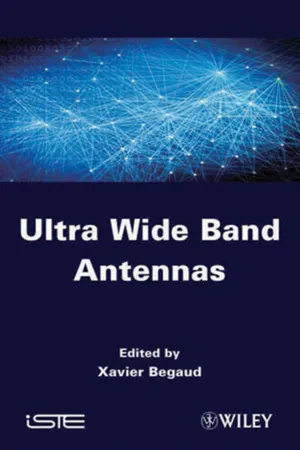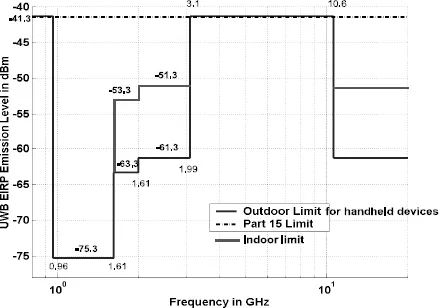
This is a test
- English
- ePUB (mobile friendly)
- Available on iOS & Android
eBook - ePub
Ultra Wide Band Antennas
Book details
Book preview
Table of contents
Citations
About This Book
Ultra Wide Band Technology (UWB) has reached a level of maturity that allows us to offer wireless links with either high or low data rates. These wireless links are frequently associated with a location capability for which ultimate accuracy varies with the inverse of the frequency bandwidth. Using time or frequency domain waveforms, they are currently the subject of international standards facilitating their commercial implementation. Drawing up a complete state of the art, Ultra Wide Band Antennas is aimed at students, engineers and researchers and presents a summary of internationally recognized studies.
Frequently asked questions
At the moment all of our mobile-responsive ePub books are available to download via the app. Most of our PDFs are also available to download and we're working on making the final remaining ones downloadable now. Learn more here.
Both plans give you full access to the library and all of Perlego’s features. The only differences are the price and subscription period: With the annual plan you’ll save around 30% compared to 12 months on the monthly plan.
We are an online textbook subscription service, where you can get access to an entire online library for less than the price of a single book per month. With over 1 million books across 1000+ topics, we’ve got you covered! Learn more here.
Look out for the read-aloud symbol on your next book to see if you can listen to it. The read-aloud tool reads text aloud for you, highlighting the text as it is being read. You can pause it, speed it up and slow it down. Learn more here.
Yes, you can access Ultra Wide Band Antennas by Xavier Begaud, Xavier Begaud in PDF and/or ePUB format, as well as other popular books in Tecnología e ingeniería & Ingeniería eléctrica y telecomunicaciones. We have over one million books available in our catalogue for you to explore.
Information
Chapter 1
Applications of Ultra Wide Band Systems 1
1.1. Introduction
The first definition of the Ultra Wide Band Systems (UWB) for commercial applications was provided in February 2002 by the FCC (Federal Communications Commission) [FCC 02]. This definition, based on the occupied bandwidth, defines as Ultra Wide Band any system having a bandwidth higher than or equal to 500 MHz or having a ratio between its carrier frequency and the occupied bandwidth higher than 25%.
This definition made it possible to count various forms of UWB waveforms with all the criteria. Among the most conventional UWB waveforms, we can note the Impulse Radio waveform and the MBOFDM (Multi Band Orthogonal Frequency-Division Multiplexing) waveform. However, the definition stated by the FCC allowed other forms of less conventional waveforms to be created. Among these we can detail the Frequency Hopping waveforms on the one hand and the chirp waveform on the other hand.
These various forms of UWB made it possible to define two main categories of applications:
– High and very high data rate UWB applications enabling wireless communications with a data rate of 480 Mb/s or even 1 Gb/s. For these applications, the MB-OFDM solution was defined in various standards.
– Low data rate UWB applications having, in addition to communication services, localization services inside buildings, thus having a service comparable to GPS (global positioning system) but inside.
1.2. UWB regulation: a complex context
1.2.1. UWB regulation in the USA
In February 2002, the FCC allocated a frequency band for UWB systems for communications applications, ground penetration radars, through-wall imaging, medical applications, security applications as well as radar applications for vehicles. For communications applications, the FCC differentiated the use of UWB systems inside and outside buildings.
The frequency band authorized in the United States for communication and localization applications is between 3.1 GHz and 10.6 GHz with a maximum mean Equivalent Isotropic Radiated Power (E.I.R.P, see Chapter 2) of −41.3 dBm/MHz. Figure 1.1 presents the emission mask authorized by the FCC in 2002 for communications like those inside buildings and those for handheld devices used outdoors.
Figure 1.1. Emission mask authorized by the FCC in 2002

For communication outside buildings, only mobiles are permitted and the authorized levels are 10 dB lower than those tolerated for communications inside buildings. The term “Part 15 limit” in Figure 1.1 relates to the limit tolerated by the FCC for non-intentional emissions, i.e. the radiation produced by electric household appliances for example.
1.2.2. UWB regulation in Europe
In March 2006, the CEPT (Conference Européenne des Postes et Telecommunications — European Post and Telecommunications Conference) gave, through ECC TG3 (Electronic Communications Committee Task Group 3), the first European authorization for UWB systems [ECC 06a]. This first decision authorizes these devices in the 6-8.5 GHZ band without any mitigation techniques (used to reduce interferences) with a maximum mean E.I.R.P. of −41.3 dBm/MHz.
In December 2006, the principle of progressive approach (phased approach) in the frequency band 4.2-4.8 GHz was accepted by the ECC. This allowed the introduction into Europe of a first generation of UWB equipment in this frequency band, with a maximum mean E.I.R.P. of −41.3 dBm/MHz without any mitigation techniques. The introduction of this first generation of UWB equipment is authorized until December 31st, 2010.
Following this decision, in July 2007, the ECC amended its first decision for the generic UWB systems without license. Table 1.1 presents this decision which does not reveal the techniques of mitigation authorized in the 3.4-4.8 GHz band, as they are defined in another ECC decision. It should be noted that, in this decision, UWB systems are not authorized on aircraft, nor on fixed outside infrastructures, but are authorized in vehicles if they implement a Transmit Power Control such as the one defined in Table 1.1.
The European commission published, in February 2007, a decision relating to the use of UWB equipment without license in Europe, taking again the points mentioned above. The European countries were required to apply this decision from September 2007 [ECC 07].
In the 3.1-4.8 GHz band and 8.5-9 GHz band, UWB equipment must apply mitigation techniques in order to protect the already existing services in these bands. If they implement mitigation techniques, UWB devices are authorized to transmit in these bands with a maximum mean E.I.R.P. of −41.3 dBm/MHz. In the 4.2-4.8 GHZ band, these methods are not mandatory until the end of December 2010.
In December 2006, CEPT adopted the first decision relating to the mitigation techniques in the 3.4-4.8 GHZ band. This decision was amended in October 2008.
This amendment defines at the same time both the LDC (Low Duty Cycle) mitigation technique in the 3.1-4.8 GHz band and the DAA (Detect And Avoid) mitigation technique in the 3.1-4.8 GHz and 8.5-9 GHz bands. These techniques were defined in order to protect WiMAX and radiolocation services while allowing a maximum mean E.I.R.P. of −41.3 dBm/MHz in these bands.
If these mitigation techniques are not implemented, the levels of power authorized in these bands are defined in Table 1.1.
Table 1.1. Decisions of the ECC in July 2007
| Frequency range | Maximum mean E.I.R.P. spectral density) (dBm/MHz) | Maximum peak E.I.R.P. (measured in 50 MHz) |
| Below 1.6 GHz | −90 dBm/MHz | −50 dBm |
| 1.6 to 2.7 GHz | −85 dBm/MHz | −45 dBm |
| 2.7 to 3.4 GHz | −70 dBm/MHz | −36 dBm |
| 3.4 to 3.8 GHz | −80 dBm/MHz | −40 dBm |
| 3.8 to 4.2 GHz | −70 dBm/MHz | −30 dBm |
| 4.2 to 4.8 GHz (Notes 1 and 2) | −70 dBm/MHz | −30 dBm |
| 4.8 to 6 GHz | −70 dBm/MHz | −30 dBm |
| 6 to 8.5 GHz (Note 2) | −41.3 dBm/MHz | 0 dBm |
| 8.5 to 10.6 GHz | −65 dBm/MHz | −25 dBm |
| Above 10.6 GHz | −85 dBm/MHz | −45 dBm |
| Note 1: UWB equipment placed on the market before December 31st, 2010 is authorized in the 4.2-4.8 GHz frequency band with a maximum mean E.I.R.P. spectral density of −41.3 dBm/MHz, and a maximum peak E.I.R.P. of 0 dBm measured in 50 MHz. | ||
| Note 2: In case of devices installed in road and rail vehicles, operation is subject to the implementation of Transmit Power Control (TPC) with a range of 12 dB with respect to the maximum permitted radiated power. If no TPC is implemented, the maximum authorized mean E.I.R.P. spectral density is limited to −53.3 dBm/MHz. | ||
Restriction LDC, which consists of limiting in time UWB emissions, is especially applicable to low data rate UWB applications.
With this technique, the sum of all the transmissions (by equipment) must be less than 5% of the time over one second and less than 0.5% of the time over one hour. Moreover, the duration of each transmission should not exceed 5 ms. Note that UWB equipment operation on board vehicles ...
Table of contents
- Cover
- Title Page
- Copyright
- Preface
- Chapter 1: Applications of Ultra Wide Band Systems
- Chapter 2: Radiation Characteristics of Antennas
- Chapter 3: Representation, Characterization and Modeling of Ultra Wide Band Antennas
- Chapter 4: Experimental Characterization of UWB Antennas
- Chapter 5: Overview of UWB Antennas
- Chapter 6: Antenna-Channel Joint Effects in UWB
- Appendices
- Acronyms and Abbreviations
- Bibliography
- List of Authors
- Index